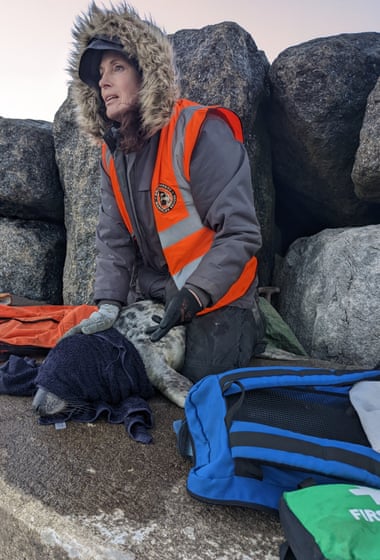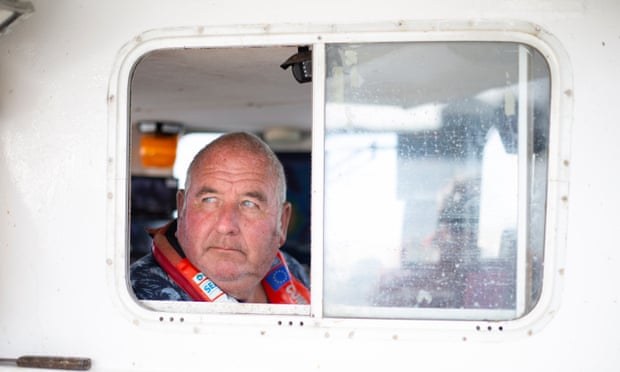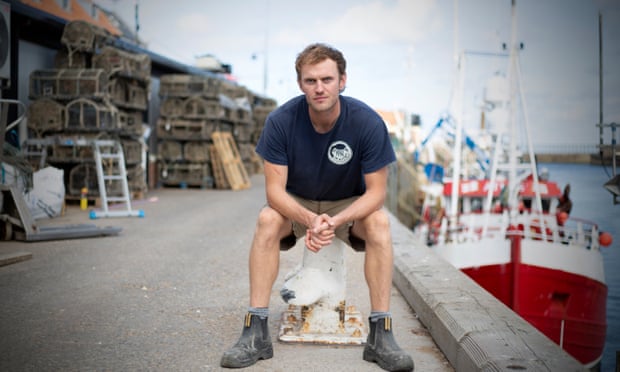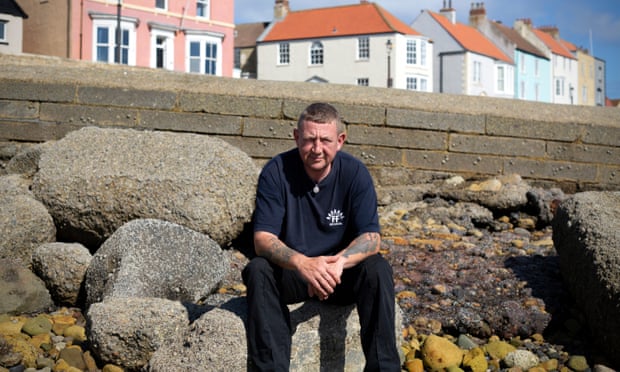‘We just want the truth’: British coastal towns fight for answers over mystery sealife deaths | Environment
[ad_1]
Stan Rennie has indelicate hands that aren’t good for typing. He’s not the kind of person who cares much for technology at all.
But over the last year, the fisherman has found himself spending less time outdoors and more time glued to his computer, tapping out stern emails to politicians and researching niche areas of environmental law. “It’s taken over his life,” his daughter Sarah, 36, says.
Until recently, Rennie’s existence had been largely peaceful. Most mornings, he would head out to his small blue and white boat, the Sarah Lynn, and spend hours catching crabs off the Hartlepool headland. His wife Lynn would keep an eye on him from the living room window – just in case – as he pulled in rope-knotted baskets from the water, brimming with the day’s catch.
But on 28 September 2021, everything changed. For the first time in Rennie’s memory, his traps were near empty. The crabs he did catch were twitching, unhealthy, and died within minutes. “I didn’t have a clue what was happening,” says Rennie, 61. “After nearly 50 years of fishing, I said to my brother, ‘I’ve never known anything like this before’.”

The mystery of what caused the deaths is one that has consumed Rennie and thrust his small coastal community, along with others in the north-east of England, into the centre of a national political drama.
His story – of empty traps and dying crabs – was far from unique; from prawn trawlers to lobster fishers, “everybody was getting nothing”, he says. Over a cup of tea in a cabin near the port, Paul Widdowfield leafs through notes in his battered log book, detailing how, his catch, too, “fell off a cliff”.

Onshore, meanwhile, corpses were mounting. Photographs showing thousands of dead and dying crabs and lobsters piled up on the sand along the north-east coast, including in Redcar, Saltburn and South Gare, made the news in early October. Further die-offs have followed. Starving seals and dead seabirds were also being recorded in an increasing number, campaigners say – while vets reported a spike in dogs falling ill with nausea and vomiting after being taken for walks on beaches from Scarborough to Seaton Carew.
From the beginning, many in the community feared a pollution incident caused by dredging could be to blame. “There were piles of crabs and lobsters laid on their backs, twitching. A lot of them were blowing bubbles out of their gills and staggering around,” says Sally Bunce, 53, a former police officer and environmentalist who has joined forces with Rennie to investigate.
“It looked like their nervous systems had gone,” Rennie, adds. “It was like they’d been poisoned.”
At first, it seemed as though the government was taking the issue seriously. The Environment Agency, part of Defra, promised to investigate, pledging to send samples of water, sediment and crab for analysis, which they said would examine the theory that pollution was to blame. Then in February this year, the official answer came. Concerns that dredging work in September had disturbed toxic sediment in the River Tees were dismissed because there was “no evidence of a link” between that and the die-offs, Defra’s report said. Instead, it concluded, the most likely factor was a “naturally occurring harmful algal bloom”.
When he read through the findings, Rennie was puzzled. The impact of the die-offs had already been devastating. If they couldn’t be stopped, the consequences for jobs, tourism and the marine environment could become a “national disaster”. But Defra had seemingly ruled out pollution – which he and other fishermen believed to be the most likely cause – without being sure of the actual cause. The question was: why?
Even before Defra’s findings had been published, locals were raising concerns about dredging. They’d seen a dredging vessel at the mouth of the Tees days before the die-offs began. Data from the automatic identification system, which tracks vessels, later confirmed that beginning on 25 September, a 78-metre, 3,000-tonne dredger conducted 10 days of routine dredging, removing sediment from the river mouth and dumping it a few miles off the Redcar coast.

When they suggested there might be a link, they felt they were dismissed. Joe Redfern, a marine biologist based in Whitby, recalls the moment he lost faith in the formal investigation at a meeting in December. “We basically said: ‘Everything’s dying and we’re really concerned.’ And they said: ‘Well, you’re not going to trust any work we do. So you’re gonna have to go out and do your own research,’” he says.
They took matters into their own hands. Redfern and other members of the North East Fishing Collective commissioned Tim Deere-Jones, a marine pollution consultant, to research the die-offs, using money raised through a fundraising appeal. Deere-Jones’s initial findings, also published in February , reiterated concerns about the algal bloom theory, for which he said there was “no empirical evidence”.
It also noted Defra’s own data, obtained through freedom of information requests, which had found extremely high levels of the chemical pyridine in the crab corpses collected in Saltburn.
According to Defra’s analysis, crab corpses taken from Saltburn – one of the areas in the north-east affected by the die-offs – contained up to 430mg per kg of pyridine – 72 times higher than the control sample taken from Cornwall.
The fishermen urged Defra to more closely consider the possibility that dredging had led to the release of pyridine and that the crab die-offs were a chemical pollution incident, rather than a natural event. Pyridine, which is used to make pesticides and is a byproduct of steel production, had historically been made in Teesside. And while research into the effects on crabs specifically has not yet been published, the World Health Organization describes the chemical as “harmful to aquatic organisms”.
But Defra denied the finding was significant, saying that while pyridine had been found in the crabs, further investigations found it was “generally not detected in the water samples”. “As such, any levels [of pyridine] detected in crab tissue are likely to be linked to biological processes and not necessarily from the environment,” a spokesperson said.
In March, the department closed its investigation.

For members of the community, distrust of the official explanation has been made worse by a perceived lack of transparency and concerns that other factors – beyond simply investigating the cause of the die-offs – are at play behind the scenes.
If dredging was proven to be a factor in the die-offs, the political ramifications would be huge. The success of a new freeport in the Tees Valley – seen as key to the Conservatives’ post-Brexit levelling-up agenda – rides on the ability to dredge in the Tees, historically one of the UK’s most polluted rivers as a result of waste products from heavy industry being dumped there over decades.
The flagship development, the government claims, will create jobs and reboot the local economy by offering tax breaks and streamlined customs for businesses.
While the dredging in autumn was not directly linked to the freeport, preparation for the development is expected to require millions of tonnes of material to be dredged from areas directly next to the sediment that the campaigners believe caused the die-offs.
Documents released through Environmental Information Regulation requests to PD Ports, which manages the Teesport, also suggest that the authorities were scrambling to issue a “rebuttal” to Deere-Jones’s report following pressure from ministers seeking to shift the blame away from dredging activities.
The documents, obtained by openDemocracy last month, suggest that the investigators had not ruled out manmade activities as a cause of the bloom, with minutes from a December meeting noting: “This event is generally natural, but it does not mean it could not be influenced by human intervention.”
Another email between investigators at the UK Health Security Agency said: “Released nutrients from e.g. dredging could theoretically influence algal bloom.” Other documents reveal that the EA seemingly ruled out both “algae toxins” and a “natural event” in a November 2021 presentation. The PowerPoint said the “behaviour and longevity mean it is unlikely that a ‘natural event’ caused the deaths”, adding that dredging was the “most serious line of enquiry to be investigated”.
Over the last month, calls for Defra to reopen its investigation have intensified. Blanaid Denman, senior conservation officer for the RSPB, said she was “deeply concerned” by the issue and the “potential effects on the wider marine ecosystem”. She added that dredging of the Tees should be halted “until a full scientific analysis can rule it out as a contributory factor”.

But the agency has stuck to its algal bloom explanation. In a statement, a spokesman said: “A summary of our findings from our comprehensive investigation into this issue was published in May and we are not reopening that investigation. We continue to monitor shellfish stocks and carry out further testing as part of our standard duties.
“Government scientists carried out extensive testing for chemicals and other pollutants including pyridine but concluded a naturally occurring algal bloom was the most likely cause. The amount of any chemical needed to cause a mortality event of this scale would have had to be huge and could not have escaped detection in the extensive sampling carried out at the time.”
On Thursday night, it emerged that the feared dredging had begun in the Tees as part of work on the new Teesworks development. The first stage will see 125,000 cubic metres of material dredged by civil engineering firm Graham on behalf of the South Tees Development Corporation, and is expected to go on for eight weeks. In a statement, the corporation said “all official scientific investigations to date have ruled out dredging” and that any dredging works it carries out “will be to the highest standards, far exceeding the baseline legal requirements”.
The announcement followed a BBC interview with Ben Houchen, the Conservative Tees Valley mayor – and a key proponent of the freeport – in which he appeared to dismiss those calling for further testing as conspiracy theorists.
“It’s not just pyridine,” he said, “they think it’s Agent Orange, apparently from secret factories in the second world war. We’ve also been told that it was Russian submarines trying to cause problems for the UK government.
“So I’m sure you’re not suggesting, and they are suggesting, that we do testing for these types of completely conspiratorial ideas because if we do that, we’ll never get this development under way and finished.”
Houchen says his words were edited out of context and has submitted a complaint to the BBC.
He says “the focus now needs to be on ensuring the livelihoods of in the fishing community are protected”, and is pressing the government for financial support to help those affected.
Determined to dig up the answer themselves, the fishermen have commissioned local universities to conduct further independent research into the die-offs, which is expected to be published later this month. The research relates to the effects of pyridine on crabs, the levels of pyridine in the Tees and algal blooms.
Campaigners believe that, until further investigations are completed, dredging work should be paused. “We’re not trying to detail the freeport but we don’t want it to be done at the expense of the community and the environment,” Bunce, the former police officer, says. “If we lose the tourism industry, and if we lose the sea… that’s a massive thing to play with.”
In the meantime, the mystery die-offs continue to have a devastating impact.
During an outing on his boat off Hartlepool on Friday, Rennie caught just 12 brown crabs and one lobster from 140 pots.
It’s not just about him or the other fishers, he says – but about protecting the marine environment for future generations. “If someone said to me, ‘Do you want £200,000 or your ecosystem back?’, I’d say the ecosystem,’” he says. “We’re not activists, we’re fishermen. We just want to know the truth.”
[ad_2]
Stan Rennie has indelicate hands that aren’t good for typing. He’s not the kind of person who cares much for technology at all.
But over the last year, the fisherman has found himself spending less time outdoors and more time glued to his computer, tapping out stern emails to politicians and researching niche areas of environmental law. “It’s taken over his life,” his daughter Sarah, 36, says.
Until recently, Rennie’s existence had been largely peaceful. Most mornings, he would head out to his small blue and white boat, the Sarah Lynn, and spend hours catching crabs off the Hartlepool headland. His wife Lynn would keep an eye on him from the living room window – just in case – as he pulled in rope-knotted baskets from the water, brimming with the day’s catch.
But on 28 September 2021, everything changed. For the first time in Rennie’s memory, his traps were near empty. The crabs he did catch were twitching, unhealthy, and died within minutes. “I didn’t have a clue what was happening,” says Rennie, 61. “After nearly 50 years of fishing, I said to my brother, ‘I’ve never known anything like this before’.”

The mystery of what caused the deaths is one that has consumed Rennie and thrust his small coastal community, along with others in the north-east of England, into the centre of a national political drama.
His story – of empty traps and dying crabs – was far from unique; from prawn trawlers to lobster fishers, “everybody was getting nothing”, he says. Over a cup of tea in a cabin near the port, Paul Widdowfield leafs through notes in his battered log book, detailing how, his catch, too, “fell off a cliff”.

Onshore, meanwhile, corpses were mounting. Photographs showing thousands of dead and dying crabs and lobsters piled up on the sand along the north-east coast, including in Redcar, Saltburn and South Gare, made the news in early October. Further die-offs have followed. Starving seals and dead seabirds were also being recorded in an increasing number, campaigners say – while vets reported a spike in dogs falling ill with nausea and vomiting after being taken for walks on beaches from Scarborough to Seaton Carew.
From the beginning, many in the community feared a pollution incident caused by dredging could be to blame. “There were piles of crabs and lobsters laid on their backs, twitching. A lot of them were blowing bubbles out of their gills and staggering around,” says Sally Bunce, 53, a former police officer and environmentalist who has joined forces with Rennie to investigate.
“It looked like their nervous systems had gone,” Rennie, adds. “It was like they’d been poisoned.”
At first, it seemed as though the government was taking the issue seriously. The Environment Agency, part of Defra, promised to investigate, pledging to send samples of water, sediment and crab for analysis, which they said would examine the theory that pollution was to blame. Then in February this year, the official answer came. Concerns that dredging work in September had disturbed toxic sediment in the River Tees were dismissed because there was “no evidence of a link” between that and the die-offs, Defra’s report said. Instead, it concluded, the most likely factor was a “naturally occurring harmful algal bloom”.
When he read through the findings, Rennie was puzzled. The impact of the die-offs had already been devastating. If they couldn’t be stopped, the consequences for jobs, tourism and the marine environment could become a “national disaster”. But Defra had seemingly ruled out pollution – which he and other fishermen believed to be the most likely cause – without being sure of the actual cause. The question was: why?
Even before Defra’s findings had been published, locals were raising concerns about dredging. They’d seen a dredging vessel at the mouth of the Tees days before the die-offs began. Data from the automatic identification system, which tracks vessels, later confirmed that beginning on 25 September, a 78-metre, 3,000-tonne dredger conducted 10 days of routine dredging, removing sediment from the river mouth and dumping it a few miles off the Redcar coast.

When they suggested there might be a link, they felt they were dismissed. Joe Redfern, a marine biologist based in Whitby, recalls the moment he lost faith in the formal investigation at a meeting in December. “We basically said: ‘Everything’s dying and we’re really concerned.’ And they said: ‘Well, you’re not going to trust any work we do. So you’re gonna have to go out and do your own research,’” he says.
They took matters into their own hands. Redfern and other members of the North East Fishing Collective commissioned Tim Deere-Jones, a marine pollution consultant, to research the die-offs, using money raised through a fundraising appeal. Deere-Jones’s initial findings, also published in February , reiterated concerns about the algal bloom theory, for which he said there was “no empirical evidence”.
It also noted Defra’s own data, obtained through freedom of information requests, which had found extremely high levels of the chemical pyridine in the crab corpses collected in Saltburn.
According to Defra’s analysis, crab corpses taken from Saltburn – one of the areas in the north-east affected by the die-offs – contained up to 430mg per kg of pyridine – 72 times higher than the control sample taken from Cornwall.
The fishermen urged Defra to more closely consider the possibility that dredging had led to the release of pyridine and that the crab die-offs were a chemical pollution incident, rather than a natural event. Pyridine, which is used to make pesticides and is a byproduct of steel production, had historically been made in Teesside. And while research into the effects on crabs specifically has not yet been published, the World Health Organization describes the chemical as “harmful to aquatic organisms”.
But Defra denied the finding was significant, saying that while pyridine had been found in the crabs, further investigations found it was “generally not detected in the water samples”. “As such, any levels [of pyridine] detected in crab tissue are likely to be linked to biological processes and not necessarily from the environment,” a spokesperson said.
In March, the department closed its investigation.

For members of the community, distrust of the official explanation has been made worse by a perceived lack of transparency and concerns that other factors – beyond simply investigating the cause of the die-offs – are at play behind the scenes.
If dredging was proven to be a factor in the die-offs, the political ramifications would be huge. The success of a new freeport in the Tees Valley – seen as key to the Conservatives’ post-Brexit levelling-up agenda – rides on the ability to dredge in the Tees, historically one of the UK’s most polluted rivers as a result of waste products from heavy industry being dumped there over decades.
The flagship development, the government claims, will create jobs and reboot the local economy by offering tax breaks and streamlined customs for businesses.
While the dredging in autumn was not directly linked to the freeport, preparation for the development is expected to require millions of tonnes of material to be dredged from areas directly next to the sediment that the campaigners believe caused the die-offs.
Documents released through Environmental Information Regulation requests to PD Ports, which manages the Teesport, also suggest that the authorities were scrambling to issue a “rebuttal” to Deere-Jones’s report following pressure from ministers seeking to shift the blame away from dredging activities.
The documents, obtained by openDemocracy last month, suggest that the investigators had not ruled out manmade activities as a cause of the bloom, with minutes from a December meeting noting: “This event is generally natural, but it does not mean it could not be influenced by human intervention.”
Another email between investigators at the UK Health Security Agency said: “Released nutrients from e.g. dredging could theoretically influence algal bloom.” Other documents reveal that the EA seemingly ruled out both “algae toxins” and a “natural event” in a November 2021 presentation. The PowerPoint said the “behaviour and longevity mean it is unlikely that a ‘natural event’ caused the deaths”, adding that dredging was the “most serious line of enquiry to be investigated”.
Over the last month, calls for Defra to reopen its investigation have intensified. Blanaid Denman, senior conservation officer for the RSPB, said she was “deeply concerned” by the issue and the “potential effects on the wider marine ecosystem”. She added that dredging of the Tees should be halted “until a full scientific analysis can rule it out as a contributory factor”.

But the agency has stuck to its algal bloom explanation. In a statement, a spokesman said: “A summary of our findings from our comprehensive investigation into this issue was published in May and we are not reopening that investigation. We continue to monitor shellfish stocks and carry out further testing as part of our standard duties.
“Government scientists carried out extensive testing for chemicals and other pollutants including pyridine but concluded a naturally occurring algal bloom was the most likely cause. The amount of any chemical needed to cause a mortality event of this scale would have had to be huge and could not have escaped detection in the extensive sampling carried out at the time.”
On Thursday night, it emerged that the feared dredging had begun in the Tees as part of work on the new Teesworks development. The first stage will see 125,000 cubic metres of material dredged by civil engineering firm Graham on behalf of the South Tees Development Corporation, and is expected to go on for eight weeks. In a statement, the corporation said “all official scientific investigations to date have ruled out dredging” and that any dredging works it carries out “will be to the highest standards, far exceeding the baseline legal requirements”.
The announcement followed a BBC interview with Ben Houchen, the Conservative Tees Valley mayor – and a key proponent of the freeport – in which he appeared to dismiss those calling for further testing as conspiracy theorists.
“It’s not just pyridine,” he said, “they think it’s Agent Orange, apparently from secret factories in the second world war. We’ve also been told that it was Russian submarines trying to cause problems for the UK government.
“So I’m sure you’re not suggesting, and they are suggesting, that we do testing for these types of completely conspiratorial ideas because if we do that, we’ll never get this development under way and finished.”
Houchen says his words were edited out of context and has submitted a complaint to the BBC.
He says “the focus now needs to be on ensuring the livelihoods of in the fishing community are protected”, and is pressing the government for financial support to help those affected.
Determined to dig up the answer themselves, the fishermen have commissioned local universities to conduct further independent research into the die-offs, which is expected to be published later this month. The research relates to the effects of pyridine on crabs, the levels of pyridine in the Tees and algal blooms.
Campaigners believe that, until further investigations are completed, dredging work should be paused. “We’re not trying to detail the freeport but we don’t want it to be done at the expense of the community and the environment,” Bunce, the former police officer, says. “If we lose the tourism industry, and if we lose the sea… that’s a massive thing to play with.”
In the meantime, the mystery die-offs continue to have a devastating impact.
During an outing on his boat off Hartlepool on Friday, Rennie caught just 12 brown crabs and one lobster from 140 pots.
It’s not just about him or the other fishers, he says – but about protecting the marine environment for future generations. “If someone said to me, ‘Do you want £200,000 or your ecosystem back?’, I’d say the ecosystem,’” he says. “We’re not activists, we’re fishermen. We just want to know the truth.”

